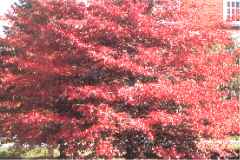Vol.2 #138
September 21, 2001
"Black Gum"...Nyssa
sylvatica
 One
of my favorite native trees of the Eastern United States is the "Black
Gum" or Nyssa sylvatica. The tree is also known as "Sour Gum"
or the "Tupelo". This tree should not be confused with the "Sweet
Gum" (Liquidambar styraciflua), renowned for its spiny gum balls
which are slightly smaller than a golf ball. The Black Gum sports
glossy, ovate leaves which distinguish the tree from others in the forest.
The leaves look as though they have had an intense treatment of Turtle
Wax. This is a characteristic which I particularly enjoy.
One
of my favorite native trees of the Eastern United States is the "Black
Gum" or Nyssa sylvatica. The tree is also known as "Sour Gum"
or the "Tupelo". This tree should not be confused with the "Sweet
Gum" (Liquidambar styraciflua), renowned for its spiny gum balls
which are slightly smaller than a golf ball. The Black Gum sports
glossy, ovate leaves which distinguish the tree from others in the forest.
The leaves look as though they have had an intense treatment of Turtle
Wax. This is a characteristic which I particularly enjoy.
The leaves of this plant are among the last to emerge in the spring, leading
one to wonder if they had lost the tree during the course of the winter.
In the fall the leaves turn early, yielding a brilliant blaze red foliage.
In accounting, we would call this "LIFO" or "Last In, First Out".
The small white flowers are insignificant with regard to ornamental value.
During the course of the summer the tree develops loose clusters of small
fruits which are deep purple. These fruits ripen by October and can
be an issue if growing above walkways or decks.
The tree itself is generally more upright than broad with a good branching
structure. The plant may grow to 85 feet in height, though its growth
rate is about a foot per year. Native to the woodlands, the tree
tolerates full sun to partial shade. Black gum is tolerant of areas
with high moisture levels with good drainage, but will also grow in dry
areas provided some moisture is supplied to the juvenile tree.
The name "Black Gum" is derived form the near black bark of the mature
tree. Pests tend not to be a problem. Black Gum is a good street
tree though it will not be thrilled by heavy amounts of pollution.
This tree does not transplant easily. For this reason the plants
are not often found in nurseries, and are higher in price than other trees,
due to the fact that it is also more difficult to propagate. When
thinking of shade trees, I feel Black Gum is well worth your consideration.
Andy Lynn
 One
of my favorite native trees of the Eastern United States is the "Black
Gum" or Nyssa sylvatica. The tree is also known as "Sour Gum"
or the "Tupelo". This tree should not be confused with the "Sweet
Gum" (Liquidambar styraciflua), renowned for its spiny gum balls
which are slightly smaller than a golf ball. The Black Gum sports
glossy, ovate leaves which distinguish the tree from others in the forest.
The leaves look as though they have had an intense treatment of Turtle
Wax. This is a characteristic which I particularly enjoy.
One
of my favorite native trees of the Eastern United States is the "Black
Gum" or Nyssa sylvatica. The tree is also known as "Sour Gum"
or the "Tupelo". This tree should not be confused with the "Sweet
Gum" (Liquidambar styraciflua), renowned for its spiny gum balls
which are slightly smaller than a golf ball. The Black Gum sports
glossy, ovate leaves which distinguish the tree from others in the forest.
The leaves look as though they have had an intense treatment of Turtle
Wax. This is a characteristic which I particularly enjoy.